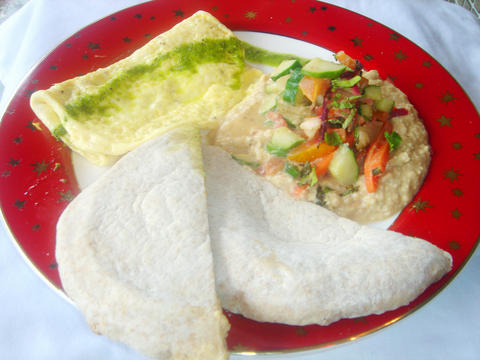Sometimes you want something different for breakfast. Something besides rice porridge, or soy milk and fried dough sticks, or the hamburgers at your local Mei Er Mei. Sometimes you want it cheap. And sometimes you want it after 11am.
The new Sababa branch near the Tai Power Building (台電大樓) delivers on all three counts. Unlike the original Sababa off Heping East Road, which doesn't open until 11am, the second location opens at 7:30am on weekdays and serves breakfast until 11:30am, maybe a bit later if you're lucky. On weekends, when the restaurant opens at 11am, breakfast is served until 3pm.
Pita and hummus are Sababa's stock in trade. Both are put to good use in the Cairo breakfast pita (NT$68), with hummus, fried egg and lettuce salad wrapped in a whole-wheat flour pita, as well as the Sababa breakfast (NT$158), a "plata" with fried eggs, pita, and a chopped tomato and cucumber salad on a bed of hummus. Sababa bakes its own pita bread and it shows. They're soft and fresh, not the dry, cracking pitas you might find at the grocery store. And Sababa's hummus would taste good even if it weren't such a rare find in Taipei. It's almost as delicately light in texture as whipped cream, with the right blend of garlic, lemon, olive oil and ground sesame flavors.

PHOTO: COURTESY OF SABABA
For the health-conscious, there's the Dead Sea breakfast: seasonal fruits, homemade yogurt and granola. For the not-so-health conscious, there's the big feast: fried eggs, bacon, french fries, a pita and chopped tomato and cucumber salad. The breakfast platas are all NT$158 and are served with your choice of coffee or mint tea.
Falafel, balls made from loosely ground chickpeas that are seasoned with garlic and fried, can be added to any order for NT$18. I'm not as keen on Sababa's falafel as I am on their hummus. They're not greasy and never taste of stale oil, which means the fryer is cleaned regularly, but they're not as crisp or aggressively seasoned as I would like. This is only a minor criticism, however, because the hummus is really good while the falafel is all right.
My only real carp is that Sababa's platas, both the breakfast and lunch/dinner varieties, are a bit on the small side. For dinner especially, one plata can seem almost like an appetizer. Then again, the dishes are cheap and freshly made from quality ingredients. If you're really hungry, just order more food.
Address: 17, Ln 283, Roosevelt Rd Sec 3, Taipei
(台北市羅斯福路三段283巷17號)
Telephone: (02) 2363-8009
Open: Monday through Friday from 7:30am to 10pm; Saturday from 11am to 10pm; Sunday from 11am to 7pm
Average meal: NT$148 to NT$246
Details: Chinese and English menu; credit cards not accepted

In the March 9 edition of the Taipei Times a piece by Ninon Godefroy ran with the headine “The quiet, gentle rhythm of Taiwan.” It started with the line “Taiwan is a small, humble place. There is no Eiffel Tower, no pyramids — no singular attraction that draws the world’s attention.” I laughed out loud at that. This was out of no disrespect for the author or the piece, which made some interesting analogies and good points about how both Din Tai Fung’s and Taiwan Semiconductor Manufacturing Co’s (TSMC, 台積電) meticulous attention to detail and quality are not quite up to

Chinese Nationalist Party (KMT) Chairman Eric Chu (朱立倫) hatched a bold plan to charge forward and seize the initiative when he held a protest in front of the Taipei City Prosecutors’ Office. Though risky, because illegal, its success would help tackle at least six problems facing both himself and the KMT. What he did not see coming was Taipei Mayor Chiang Wan-an (將萬安) tripping him up out of the gate. In spite of Chu being the most consequential and successful KMT chairman since the early 2010s — arguably saving the party from financial ruin and restoring its electoral viability —

It is one of the more remarkable facts of Taiwan history that it was never occupied or claimed by any of the numerous kingdoms of southern China — Han or otherwise — that lay just across the water from it. None of their brilliant ministers ever discovered that Taiwan was a “core interest” of the state whose annexation was “inevitable.” As Paul Kua notes in an excellent monograph laying out how the Portuguese gave Taiwan the name “Formosa,” the first Europeans to express an interest in occupying Taiwan were the Spanish. Tonio Andrade in his seminal work, How Taiwan Became Chinese,

Toward the outside edge of Taichung City, in Wufeng District (霧峰去), sits a sprawling collection of single-story buildings with tiled roofs belonging to the Wufeng Lin (霧峰林家) family, who rose to prominence through success in military, commercial, and artistic endeavors in the 19th century. Most of these buildings have brick walls and tiled roofs in the traditional reddish-brown color, but in the middle is one incongruous property with bright white walls and a black tiled roof: Yipu Garden (頤圃). Purists may scoff at the Japanese-style exterior and its radical departure from the Fujianese architectural style of the surrounding buildings. However, the property